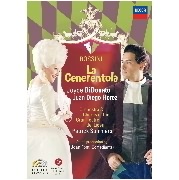Rossini’s La Cenerentola has not wanted for fine recordings; performances with Berganza, Bartoli, Baltsa, Larmore (and even Simionato), and others have appeared on CD, and on DVD there is the delicious 1981 Frederica von Stade film and charmers with a very young Bartoli and another with Ann Murray. But this new one, recorded at Barcelona’s Teatre del Liceu, takes the prize.
First of all, it is something gloriously bizarre to look at. Joan Guillen’s sets and costumes are a blaze of colors that constantly perk us up, with the characters’ hair unspared as well: one sister’s is shocking pink, the other’s is yellow; Don Magnifico’s is, at one point, lavender, with a goatee to match. The terrifically brash costumes feature off-kilter geometric patterns; the Prince’s retinue have blue hair and sport blue sunglasses later in the opera. Center stage is a hearth that becomes a door to the palace.
The production is conceived by Joan Font, the leader of a Catalan group known as Comediants; it includes eight silent dancers dressed as pointy-snouted rats who frolic about, move scenery, eavesdrop and react, help with props, and always side with Angelina (Cinderella). (This could turn into irritating street-theater, but it never does.) There’s plenty of agile movement from the cast and chorus and they often move in precise rhythm to Rossini’s beat.
What’s so lovely is that amid this silliness our hero and heroine interact with utter warmth and realism, as if their love takes them out of such a weird situation. And there’s a type of punchline at the opera’s end: Angelina winds up alone, with her rats, center stage, broom in hand, as if the entire opera had been a dream. It ideally suits the melancholy that runs through the work but is invariably ignored. If the opera really is her dream, then the phantasmagoric set and costumes imply that she ate magic mushrooms just before dozing off.
Lovely and blond, mezzo Joyce DiDonato is the ideal Cenerentola–period. She has a warm, rich tone, staggering coloratura, vibrant but never aggressive low notes, and varied dynamics, always suited to the text, at every level. She’s the perfect Rossinian. And she inhabits the role entirely: she is shy but alert to everything, she listens and reacts, she’s filled with love and forgiveness; we’re always with her. At her side, as Prince Ramiro, is Juan Diego Florez, cutting a fine figure and matching DiDonato note for note, emotion for emotion, run for run, and trill for trill. At times his tone can seem overly bright, but frankly, that’s the only criticism I can find.
David Menendez’s Dandini is somewhat over-performed, but he has a handsome voice and after a tenuous start manages the patter music well, while Bruno de Simone’s Magnifico is splendid; he even manages a type of decrepit dignity while sporting lavender hair. Simon Orfila makes Alidoro’s endless aria a thing of beauty and adds much to ensembles, and the stepsisters, acting and singing broadly, are great fun–and more importantly, on pitch. Patrick Summers elicits energy and warmth from the Liceu orchestra, and obviously relishes his superb mezzo and tenor, to whom he gives great leeway.
Picture and sound are top-notch, and there are subtitles in all major European languages, Chinese, and Catalan. A 15-minute bonus features sweet interviews with the lead singers and gives us a glimpse backstage. This is the Cenerentola to own. [3/5/2010]
































